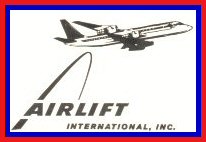Top Qs
Timeline
Chat
Perspective
Airlift International
US scheduled cargo airline (1945–1991) From Wikipedia, the free encyclopedia
Remove ads
Airlift International was an American cargo airline that operated from 1945 to 1991, initially under the name Riddle Airlines, the same Riddle as in Embry-Riddle Aeronautical University. It was certificated as a scheduled freight airline in 1951 by the Civil Aeronautics Board (CAB), the now-defunct federal agency that, at the time, tightly regulated almost all US commercial air transport. Airlift's headquarters were at Miami International Airport, Florida.[1]


Remove ads
History
Summarize
Perspective


John Paul Riddle incorporated Riddle Airlines in Florida on 28 May 1945[2] in Miami, Florida.[3] The carrier was initially a nonscheduled or irregular air carrier, but in 1951 the CAB certificated it as a scheduled freight airline between New York and Miami on the one hand and Puerto Rico on the other.[4] In 1955, the CAB awarded Riddle further certification for a portion of the north–south domestic cargo routes previously awarded to defunct U. S. Airlines.[5]
In November 1963, Riddle Airlines shareholders voted to rename the company to Airlift International,[6] a measure approved in March 1964 by the CAB.[7] In 1966, Airlift acquired the assets of defunct Slick Airways to ensure continuity of charter operations for the military.[8] In 1968, Airlift acquired the scheduled route authority of Slick.[9]

The first flights were between Miami and Puerto Rico using Curtiss C-46 and Douglas DC-4 aircraft. In 1951 it expanded services to serve New York City. Then the route system was expanded to include Chicago and Detroit. In 1960 two Douglas DC-7 were added to the fleet and with those aircraft were used for charter flights to Europe, including charters for the military.
The next aircraft type to join the fleet was the Armstrong Whitworth AW.660 Argosy dedicated cargo aircraft, but those were replaced in 1963 by the Douglas DC-8. Further aircraft used were the L-1049 Super Constellation, the Canadair CL-44, the Lockheed L-100 Hercules, the Boeing 707, and the Boeing 727-100QC.
The freight schedule was augmented by charter flights to South America and the military but by 1981 Airlift International went into Chapter 11 bankruptcy for reorganization. Following the reorganization the DC-8-54 as well as turboprop powered Fairchild Hiller FH-227 and Fairchild F-27 models were used.
Due to financial problems during 1990 and 1991, Airlift International ceased operations in June 1991.[10]
Remove ads
Fleet
As of May 1968, Airlift operated:[11]
World Airline Fleets 1979 (copyright 1979) shows Airlift with:[1]
1987–88 World Airline Fleets (copyright 1987) shows Airlift with:[12]
Other aircraft operated by Airlift and/or Riddle over the years included:
Remove ads
Accidents
- 17 December 1955: A Riddle C-46F disintegrated in flight over South Carolina with the loss of both pilots, the only people on board. The cause was traced to nonconforming elevator parts installed as part of conversion performed overseas by a contractor which created its own parts, which had left the aircraft ineligible for an airworthiness certificate.[13]
- 20 December 1957: A Riddle C-46R on departure from Miami suffered a hydraulic line rupture with subsequent fire in the right engine. The aircraft safely returned to Miami but was extensively damaged due to failure of the emergency fuel shutoff system, insufficient fire barriers and an inoperable fire bottle.[14] The aircraft had been rebuilt from the wreckage of an earlier accident (with another operator) that killed 26 people in 1951.[15]
- 30 March 1959: A Riddle C-46R suffered an intense inflight fire, over Georgia, with the subsequent crash fatal to both pilots on board, the only occupants. The probable cause was ignition of cargo in the aft belly compartment from an unguarded lightbulb.[16]
- 12 September 1966: Airlift International Flight 184/12, DC-7C N2282 from Tachikawa Air Base to Wake Island failed to rotate on takeoff due to improper loading of freight, overran the runway and was destroyed, crew survived.[17]
- 30 December 1966: DC-7C N4059K gear collapsed on takeoff from Saigon to the Philippines, leading to the destruction of the aircraft. Crew survived.[18]
- 22 June 1967: Lockheed L-1049H Super Constellation N6936C was on approach to Saigon when it collided with a USAF F-4. F-4 pilots safely ejected, but the Constellation was destroyed along with four crew and three passengers.[19]
- 24 December 1968: Lockheed L-100-10 Hercules N760AL on approach to Brit-Puk No. 1, a landing strip for a oil drilling site near Prudhoe Bay, Alaska, failed to go around despite poor visibility and crashed. The aircraft was on wet-lease to Interior Airways of Alaska, but operated by Airlift. Two of three Airlift flight crew killed. The loadmaster, an Interior employee, survived. Aviation Safety Network and NTSB is incorrectly identify this as an aircraft operated by Interior, but contemporaneous reporting is very clear.[20][21]
- 23 March 1974: DC-8-63CF N6164A undergoing maintenance at Travis Air Force Base exploded when fumes in a fuel tank ignited, killing a maintenance worker. The aircraft was destroyed.[22]
Remove ads
See also
References
External links
Wikiwand - on
Seamless Wikipedia browsing. On steroids.
Remove ads

